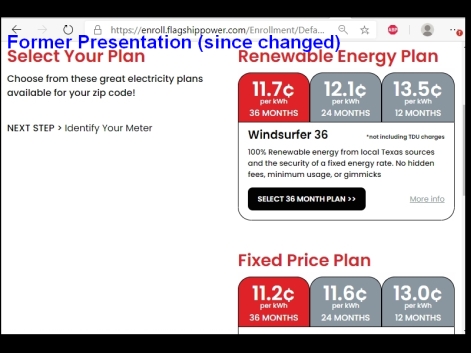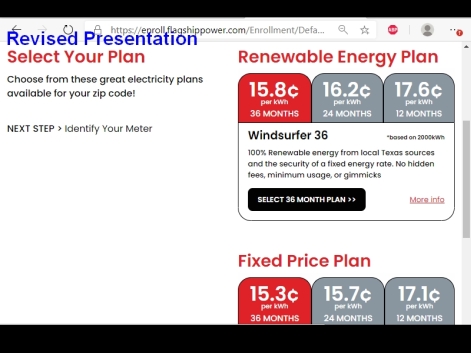|
|
|
|
|
-- Updated with Statement from SaveOnEnergy The following story is brought free of charge to readers by VertexOne, the exclusive EDI provider of EnergyChoiceMatters.com
Updated, 8:51 pm ET:
SaveOnEnergy provided the following statement concerning the matter:
"SaveOnEnergy takes pride in delivering best-in-class customer service. After review of the call recordings indicated in this complaint, we found no evidence that this customer was billed incorrectly.
"Thank you for giving us the opportunity to respond. Interactions like this provide us with an opportunity to demonstrate our pursuit of continuous and never ending improvement as a market place that serves the needs of all Texans."
--- Statement from SaveOnEnergy
Earlier
After a discussion with EnergyChoiceMatters.com (ECM), Texas retail electric provider Flagship Power informed ECM that it has revised the pricing presentation on its website to include the TDU fees when first presenting an electric plan's rates to customers (in addition to including TDU charges in other rate disclosures as the REP had been doing).
Earlier today, ECM reviewed Flagship Power's website and noted that, on the page immediately following a customer requesting plans via entering their zip code, a plan's rate would be displayed as the plan's energy rate, with the disclaimer, "* not including TDU charges". Clicking "More info" would then present the all-in (including TDU charges) average rate at various kWh levels, with links to the EFL for full details. The rates contained in the EFL included TDU charges.
For example, earlier today a customer would have been presented with a plan with a prominently displayed rate of 11.7 cents per kWh, but this rate did not include TDU charges. That specific plan's average all-in rate, at 1,000 kWh, stated on the EFL is 16.0 cents per kWh.
A screen shot of how the site formerly presented pricing, for a customer who on their own reached the Flagship website without a referral link or promo code, is below:
Flagship Power has now revised the website so the rate that the customer sees upon entering their zip code is the EFL-stated rate, at 2,000 kWh, which includes TDU charges.
A screen shot of how the site now presents pricing is below:
Flagship Power provided the following statement concerning the matter:
"Most shopping sites, including powertochoose, take a standard approach of displaying rates at the 1,000 kWh usage level. The vast majority of Flagship’s enrollments come through these types of third-party sites or are directed to specific plans through the use of targeted promo codes, or both. For a very small number of enrollments coming directly to the site, instead of using the 'one-size-fits-all' approach, Flagship has used different display methodologies (energy-only, 1,000 kWh, 2,000 kWh, etc.) to promote certain plans that are more advantageous for our potential customers. Of course, the EFL displays of 500, 1000, and 2000 were always just one easy click away for customers to see at all times. Although we stand by this approach as generally being the best option for the customer, we understand the concerns that could be raised by comparing apples and oranges, and have already made adjustments to the website to display plans at a 2,000-kwh average level. This is the closest tier to our average customers’ usage."
--- Statement from Flagship Power
ECM encountered Flagship's presentation of pricing when independently researching how the REP presented pricing to customers.
The research was undertaken to generally review Flagship's operations, due to a customer complaint filed at the Texas PUC today by a Flagship customer. However, that complaint does NOT relate to how Flagship presents its pricing to customers, either on Flagship's website or through other channels. Flagship's website pricing presentation was not the subject of the customer complaint. Rather, the complainant was signed up through a broker (SaveOnEnergy), and, according to Flagship, the customer selected through the broker a "bill credits" plan, which has more favorable pricing at certain usage.
Note: ECM does not see itself as a compliance monitor or enforcer, but does believe in sharing information with the market on behavior it comes across which may put other REPs at a competitive disadvantage and which REPs would therefore want to be cognizant of -- such as behavior which makes it easier for a competitor to win a customer or which may make a competitor's rates appear less attractive as a customer compares offerings
Additionally, though docketed (55389) at the Texas PUC, the complaint did not formally identify a respondent. Rather, the customer in a filing recounted their dissatisfaction with both SaveOnEnergy and Flagship Power. The complaint did seek relief related to both companies, but the complaint was not specifically identified as being filed "against" either one or both companies
Flagship Power issued the following statement concerning the specific customer complaint:
"This one is really a shame that the customer has had to jump through so many hoops -- it seems that he’s spoken to everyone EXCEPT us, and we could have easily helped him. We offer a 90-day guarantee for our customers that they can call in and switch to a different plan type if the first one they chose does not match their usage patterns. As you’ve covered in ECM, in addition to the refund plan he is on, we have standard fixed price plans, green plans, plans with free energy in certain periods, and even plans for customers to conserve during the highest usage periods. We would have switched him over to a new plan no problem – and of course without termination fees. Notes on his account showed that we tried numerous times to reach out to the customer after his informal complaint against SaveOn earlier this year, but he never returned our calls."
--- Statement from Flagship Power
Also notable from the customer complaint is that customer originally reached SaveOnEnergy when attempting to reach the Power to Choose site via google. There are no allegations in the complaint that SaveOnEnergy used Power to Choose branding or language, and it is unclear how the customer reached SaveOnEnergy. It is possible SaveOnEnergy organically appeared as the top result, or it is possible SaveOnEnergy was a promoted or sponsored result at the top of the search results, and even if there were no use of Power to Choose language in the SaveOnEnergy search result link, the search provider's potential presentation of sponsored links shows the challenges a customer may face in shopping
The complainant specifically alleged, "Back in January I googled Power to choose. I clicked on what I thought was the link and was forwarded to Save on Energy's website. It was there I found a telephone number and called in for assistance."
ADVERTISEMENT ADVERTISEMENT Copyright 2010-23 Energy Choice Matters. If you wish to share this story, please
email or post the website link; unauthorized copying, retransmission, or republication
prohibited.
Texas REP Changes How Pricing Presented On Website To Include TDU Fees In Initially Presented Rate
August 21, 2023
Email This Story
Copyright 2010-23 EnergyChoiceMatters.com
Reporting by Paul Ring • ring@energychoicematters.com



NEW Jobs on RetailEnergyJobs.com:
• NEW! -- Call Center Manager -- Retail Supplier
• NEW! -- Senior Billing Subject Matter - (Remote) -- Retail Supplier
|
|
|
|







